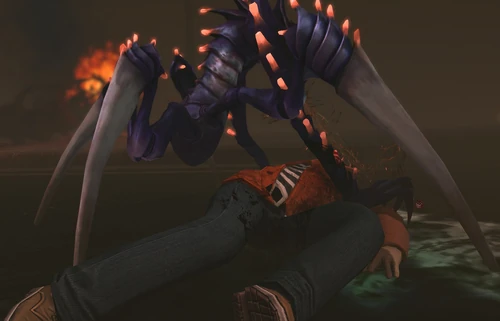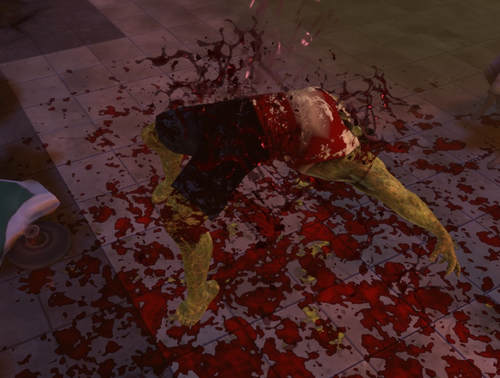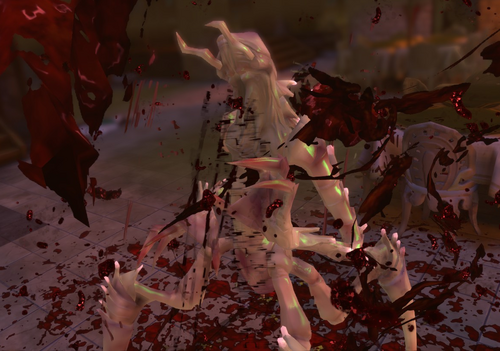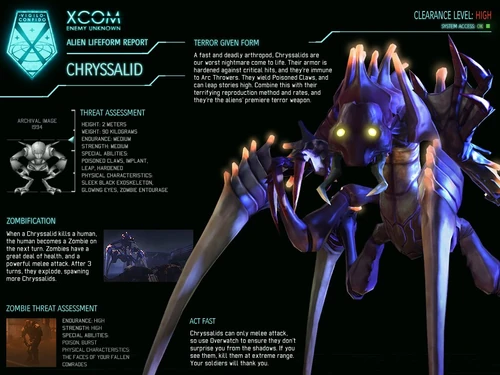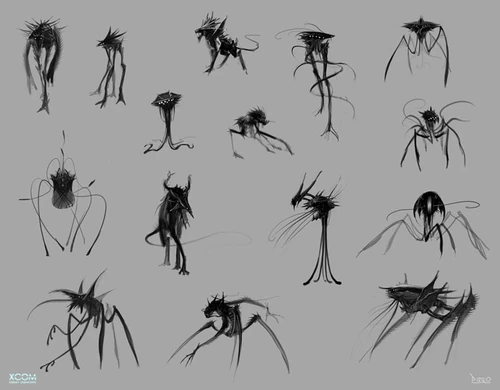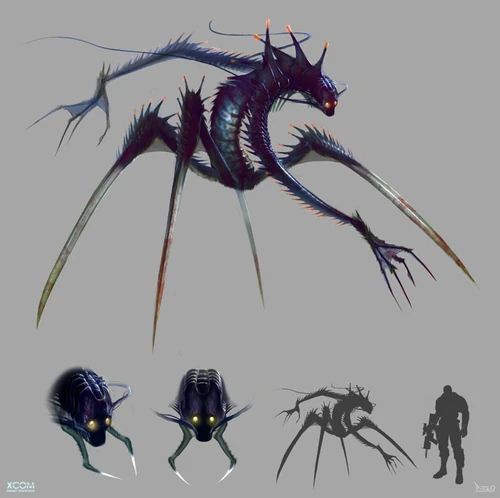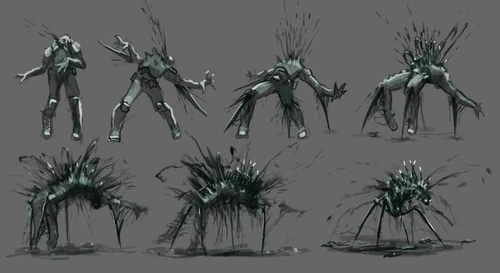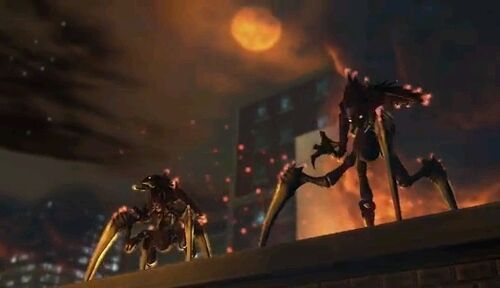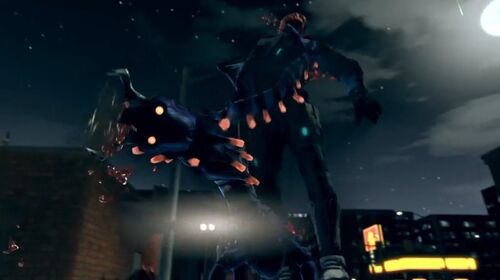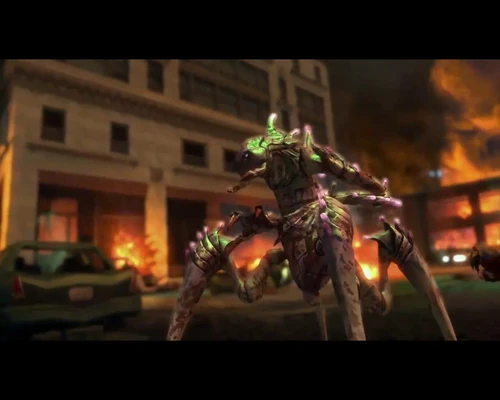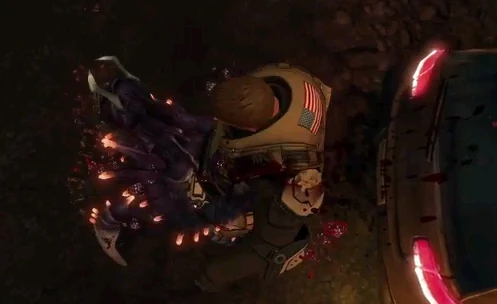- For the enemy in XCOM 2, see Chryssalid (XCOM 2).
A Chryssalid is an alien in XCOM: Enemy Unknown.
Description[]
The Chryssalid is a swift, four-legged alien with terrifying melee capabilities. Usually first encountered in small swarms on Terror Site missions, Chryssalids deal heavy damage with melee and have a high chance to inflict poison.
When a Chryssalid kills a human (a civilian or a soldier), it will implant an embryo in them. This causes the corpse to rise up as a Zombie in the next turn, which will spawn a "Chryssalid Hatchling" after three turns. Hatchlings possess behavior and statistics identical to adult Chryssalids, but have a visually lighter color of chitin armor which changes to the usual purple within a couple turns. A newborn Chryssalid can move and attack the turn it emerges. As shown in the Site Recon mission from XCOM: Enemy Within, Chryssalids can also use sufficiently large bioforms (like whales, bluefin tuna and sharks) as incubator hives.
According to the Ethereal hive mind, Chryssalids were uplifted by the Ethereals in an effort to search for "the Gift" and they were "little more than insects when their uplift began."
Life Cycle of a Chryssalid[]
Deployment[]
Chryssalids appear during the second month, "Marathon" Second Wave option notwithstanding. Their chance of being deployed declines from May to July (Marathon: June to October), as units like Cyberdiscs and Berserkers are introduced. Chryssalids can be present on several mission types, including terror sites, large UFO landings, and crash sites, but are not encountered during Abduction missions.
Abilities[]
| Ability | Description |
|---|---|
| Allows vertical leaps onto elevated surfaces during movement. | |
| Poison enemies wounded with melee attacks. | |
| Victims are implanted with a Chryssalid egg if they are killed by a Chryssalid's attack (not from poison caused by Poisonous Claws). |
Traits[]
| Trait | Description |
|---|---|
| Can only attack at close range; no ranged weapons or abilities. | |
| Immune to all poison damage. | |
| Reduces the chance of suffering a critical hit by 60%. | |
| This unit cannot be stunned with the Arc Thrower; taking a live specimen is not possible. |
Capturing[]
- Despite being obviously organic, Chryssalids cannot be stunned. They likely have a simple insectoid nervous system and the bioluminescent projections on their bodies may be sensory organs that they use like tuning forks to detect the electromagnetic fields emitted by live prey. Thus, an electric shock will not affect them in the same way as the other aliens that possess a nervous system more closely resembling that of a human's. In addition, the Chryssalids are non-sapient, so nothing of value would be gained from a prospective interrogation besides residual memories of their uplift procedures.
Research[]
- Chryssalid Autopsy - Unlocks Chitin Plating production and Biolectric Skin Gene Mod EW
Tactics[]
When facing groups of Chryssalids, you may wish to retreat to cleared territory before firing in order to create as much distance between you and the Chryssalid as possible: however, Assault soldiers with the appropriate critical-boosting abilities and a Shotgun (or, more preferably, a Scatter Laser) can kill one with a single shot at point blank range. Naturally, getting so close to a Chryssalid is potentially fatal, so providing fire support and further augmenting this tactic with the Rapid Fire ability will greatly improve your soldier's odds of survival.
As Chryssalids carry no equipment, you can freely use explosives to kill them without any penalty, and the recovered Chryssalid corpses can be used to craft Chitin Plating, an item that greatly reduces the melee damage dealt by foes like Chryssalids and Berserkers.
Overwatch can be very effective against Chryssalids as they never use cover and have to move close to their targets to attack. Assault soldiers with the ability Close Combat Specialist can exploit this rather effectively. However, Chryssalids occasionally utilize full cover in the environment to conceal their approach from your soldier's line of sight. This can be especially problematic if your soldiers are pinned down by Overwatch or Suppression.
Chryssalids can cover great distances in a single turn thanks to their exceptionally high Mobility, have just enough durability to survive multiple hits from early game weapons, and ignore cover when launching attacks. However, as research progresses and the player's gear receives improvements, their threat level decreases dramatically; by the time they're autopsied and Chitin Plating is available, the power of their melee attacks is cut in half, Titan Armor neutralizes the risk of poisoning, and all tier 3 weapons aside from the Plasma Rifle (the Plasma Sniper Rifle, the Alloy Cannon, the Heavy Plasma and the S.H.I.V. Plasma, and the Particle Cannon in Enemy Within) will kill a healthy Chryssalid in one single shot should the soldier hit their mark. A Heavy with a Blaster Launcher can destroy an entire pod of Chryssalids using their Fire Rocket ability, making Chryssalids in UFO crash or landing sites ideal for leveling up low-ranked units of this class.
Chryssalids are highly resistant to psionics: at 120 base Will the chance to Mind Control is approximately 37%. As of update 3 of the game, on Classic difficulty, the chance to Mind Control a Chryssalid with the soldier having 95 base Will and wearing Psi Armor (115 Will total) is 60%. The soldier having 100 base Will and wearing both Psi Armor and Mind Shield (and having 150 Will total) has an 85% chance to Mind Control a Chryssalid. A soldier with 120 base Will wearing Psi Armor and a Mind Shield (thus having 170 will total) has a 100% chance to Mind Control a Chryssalid.
XCOM: Enemy Within adds several new strategies against Chryssalids.
- Chryssalids are very susceptible to the Flamethrower, as revealed swarms tend to advance together toward or crowd around victims. In addition to wounding or killing a number of the aliens, the Flamethrower can also cause Chryssalids to panic and flee, making them susceptible to counter-attacks. However, this can be just as big of a problem considering the Chryssalid's high mobility. A preemptive Overwatch trap should prove effective in killing any Chryssalids that attempt to flee.
- Chryssalids are very susceptible to the luring effect of the Mimic Beacon, even when other targets are present. This can be a big help when attempting to get a high score in Terror Site missions for greater panic reduction, as it keeps them away from civilians.
- In a pinch, such as a pod reveal when few soldiers have actions available or early on when the player's limited to ballistic weapons, Chryssalids can be more or less neutralized for a few turns with a Flashbang Grenade. The "Disoriented" status effect reduces their impressive mobility to less than a Muton's, so they're likely to spend both actions on moving to a target unless they were already at close range.
Multiplayer[]
Although a Chryssalid's poison is a useful ability, they should be held in reserve and target only humans that will be killed in one attack. The ability to spawn Zombies is by far the most useful ability of the Chryssalid, and as soon as one is spawned a player should have the Zombie hide until the new Chryssalid's incubation period is completed.
Although the Chryssalid can cover a massive distance in one turn by using both actions for moving, doing so defeats the point because it cannot attack afterward. You must keep the Chryssalid hidden at all costs until an enemy comes within range. A good tactic is to keep it inside a building near a wall, then have it leap up and attack unsuspecting soldiers on the roof. They can be utilized as assassins but must one-shot the target or nothing will be gained.
Remember that Chryssalids cannot utilize cover, so it is useless to keep it directly on a corner. It must be at least one space back from an edge in order to avoid detection.
Good Against: most Humans.
Bad Against: Assaults, flying units.
Gallery[]
Trivia[]
- "Chryssalid" is a spoof on the word "chrysalis," a pod that insects, commonly caterpillars, wrap themselves in when changing.
- In the original UFO: Enemy Unknown (1994) game, Chryssalids are crab-like creatures that stand on two legs. They have the same role as quick-moving terror agents that can impregnate victims, and are often paired with Snakemen.
- The codename for their autopsy Ridley is a reference to Ridley Scott, the famous science fiction director who's well-known for the Alien movie franchise. The similarity between Chryssalids and Xenomorphs further corroborates this reference.
- Chryssalids propagate via biting, as noted in their autopsy project.
- XCOM: Enemy Within features a new Site Recon mission in which Chryssalids and Zombies are the sole enemy types encountered.
- In XCOM: Enemy Within, the Chryssalid's autopsy granting the Bioelectric Skin gene mod may be related to their apparent awareness of units that they cannot see.
- Mind Controlling a Chryssalid and then directing it to kill an enemy will not cause a Zombie to spawn, even if the enemy in question is a likewise Mind Controlled soldier. The hatchling implantation seems to extend only to humans and not other extraterrestrial lifeforms, which raises the question of how the species managed to propagate in the first place. This is likely for gameplay reasons, as shark and whale hosts are encountered in the Site Recon mission.
- Also true in Multiplayer, where a player-controlled Chryssalid cannot implant and infect an alien of the opposing team.
- A Chryssalid spawned from a Zombie will not yield a Chryssalid Corpse upon death.
| XCOM: Enemy Unknown Enemies | |
|---|---|
| Aliens | Berserker • Chryssalid • Cyberdisc • Drone • Ethereal (Uber) • Floater (Heavy) • Mechtoid Muton (Elite) • Outsider • Sectoid (Commander) • Sectopod • Seeker • Thin Man • Zombie |
| EXALT | EXALT Heavy (Elite) • EXALT Medic (Elite) • EXALT Operative (Elite) • EXALT Sniper (Elite) |


